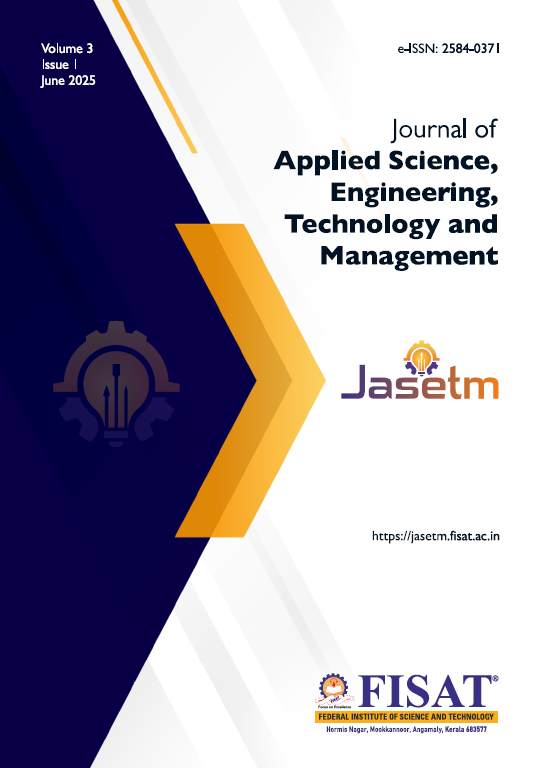IOT-Based Crack Detection in Civil Engineering Structures
DOI:
https://doi.org/10.61779/jasetm.v3i1.5Keywords:
Crack Detection, Anomaly Detection, Blynk, Real-time Monitoring, ADXL335, IoT (Internet of Things)Abstract
Structural health monitoring is essential for ensuring the safety and durability of infrastructure such as bridges and buildings. Traditional crack detection methods rely on manual inspections, which are time-consuming, labour-intensive, and prone to human error, often delaying the identification of potential structural failures. This paper presents an IoT-based crack detection system using an ESP8266 microcontroller and an ADXL335 accelerometer, programmed via the Arduino IDE and integrated with the Blynk platform for real-time monitoring. The ADXL335 measures acceleration along three axes to capture subtle vibrations, which are processed by the ESP8266 and transmitted wirelessly to Blynk, where the data is displayed as a live graph. Frequency analysis is used to detect abnormal vibration spikes that may indicate cracks. When vibrations exceed a threshold, alerts are sent to engineers via the Blynk dashboard. This low-cost, wireless system provides a reliable, scalable alternative to manual inspection, enabling early detection and timely maintenance interventions.
References
T.J. Saravanan, M. Mishra, and A.D. Aherwar, “Internet of Things (IoT)-based structural health monitoring of laboratory-scale civil engineering structures,” (2024).
Sakshi Shirkande, Ankita Shinde, and Dipak Shinde, “Detection of development of cracks in concrete structures: An IoT-based approach,” 2024.
Muhammad Sohaib, Saima Jamil, and Jong-Myon Kim, “An ensemble approach for robust automated crack detection and segmentation in concrete structures,” 2024.
Hangming Yuan, Tao Jin, and Xiaowei Ye, “Establishment and application of crowd-sensing-based system for bridge structural crack detection,” 2023.
Tao Jin, Wen Zhang, and Chunlai Chen, “Deep-learning- and unmanned aerial vehicle-based structural crack detection in concrete,” 2023.
Jiang Chen, Zizhen Zeng, and Ying Luo, “Crack detection for wading-concrete structures using water irrigation and electric heating,” 2023.
A.K. Jha, R. Kumar, and S.K. Singh, “IoT-based structural health monitoring of buildings,” IEEE Internet of Things Journal, vol. 8, no. 5, pp. 3710–3720, Mar. 2021.
M. Sharma and P. Verma, “Crack detection in concrete structures using image processing and IoT,” International Journal of Civil Engineering and Technology (IJCET), 2021.
S.R. Patel, K.K. Gupta, and R. Kumar, “Real-time monitoring of structural cracks using IoT and deep learning,” in Proceedings of the IEEE International Conference on Smart Infrastructure and Construction (ICSIC), London, UK, 2022, pp. 198–203.
R.T. Jones and D. Brown, “Application of AI and IoT in crack detection of railway tracks,” IEEE Sensors Journal, vol. 22, no. 12, pp. 13450–13458, 2022.
V.P. Golding, Z. Gharineiat, H.S. Munawar, and F. Ullah, “Crack detection in concrete structures using deep learning,” Sustainability, vol. 14, no. 13, p. 8117, 2022.
K. Patel, R. Singh, and S. Sharma, “Multi-scale U-Net architecture for crack detection in infrastructural elements,” Structural Health Monitoring, vol. 23, no. 2, pp. 345–359, 2024.
T. Nguyen and H. Tran, “Real-time crack detection using edge AI and IoT for smart infrastructure,” IEEE Internet of Things Letters, vol. 5, no. 1, pp. 200–205, 2024.
“Crack detection in building through deep learning feature extraction and machine learning approach,” Journal of Advanced Information and Communication, vol. 8, no. 1, pp. 1–6, July 2024.
H. Kaveh and R. Alhajj, “Recent advances in crack detection technologies for structures: A survey of 2022–2023 literature,” Structural Control and Health Monitoring, 2023.
Downloads
Published
How to Cite
Issue
Section
License
Copyright (c) 2025 Annmary Benny , Honey Devassy, George Thomas, Abhinav Sabu, Roel Renju

This work is licensed under a Creative Commons Attribution 4.0 International License.
Authors retain copyright and grant the journal right of first publication with the work simultaneously licensed under a Creative Commons Attribution License that allows others to share the work with an acknowledgement of the work's authorship and initial publication in this journal.
Authors are permitted and encouraged to post their work online (e.g., in institutional repositories or on their website) after the acceptance, with an acknowledgement of its initial publication in this journal, as it can lead to productive exchanges, as well as earlier and greater citation of published work.






